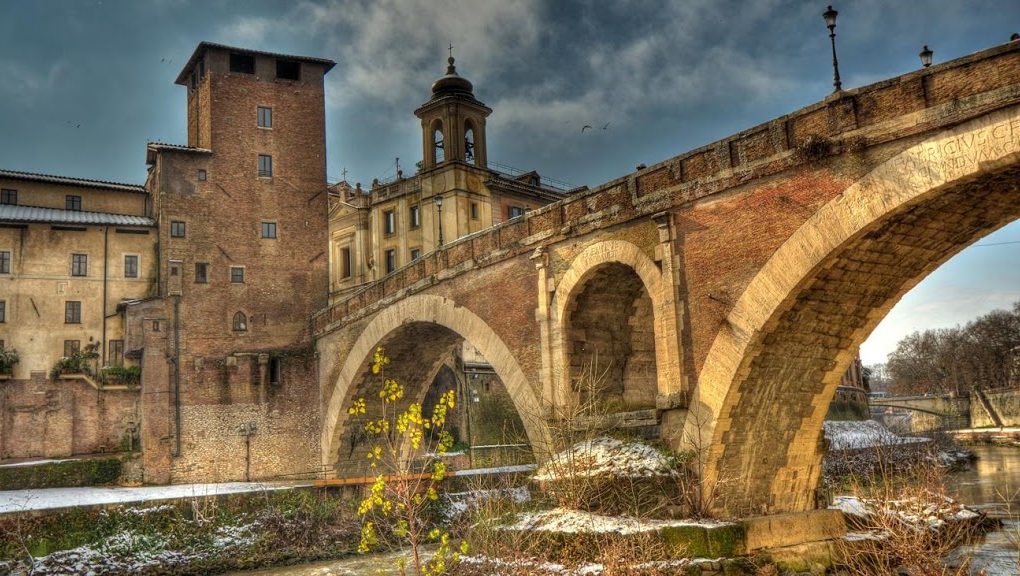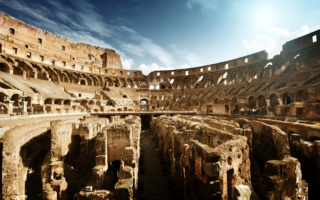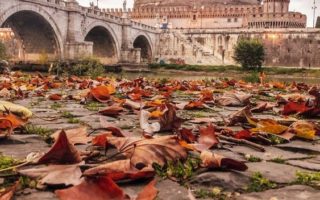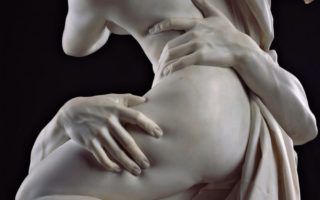A Day Tour Of Rome’s Ancient Bridges

We often hear that all roads lead to Rome, but which side exactly? Cleaved in half by the River Tiber, the Eternal City has been eternally divided; its west bank the site of tranquil Trastevere, the imposing Janiculum Hill and the Vatican; its east bank home to the temples, theatres, and forums that made up the ancient (and modern) city centre.
As caput mundi, the head of the world, Rome was at the epicentre of an empire that stretched from Scotland in the North to Egypt in the South; Portugal in the West to Syria in the East. With great power came great responsibility, and as you might expect with the world’s first metropolis of more than a million residents, the city was constantly inundated with traders, soldiers, ambassadors, and travellers.
For the city to stand it had to be united, and the task of bridging the divide of the flowing Tiber fell to a number of arch bridges. These had to be designed to bear the brunt of the city’s traffic and withstand the floods that swamped the city. But this wasn’t a problem for the architecturally savvy Romans. We are, after all, talking about a civilisation that, rather than settle elsewhere, chose to construct a giant drain (the Cloaca Maxima) and pump out the swamp water that inundated the valley between their seven hills—the site of the Roman Forum.
For the Romans, however, bridges were more than just functional, they were conceptual. It was actually the Latin word for bridge-builder (pontifex) that gave the pagan head priests, and early popes, their official title of pontifex maximus: the great bridge-builder between the profane and the divine. They were also displays of power, of Rome’s technical superiority over those it had conquered, and of mankind’s dominance over his natural landscape.
Join us at Roman Candle Tours as we take you through this underexplored yet infinitely rewarding subject. And remember, if you want to see the sites featured in the article for yourself, get in touch and we can arrange that through one of our tailored tours of Rome. We start at the easternmost bend of Trastevere on the Ponte Palatino.
Pons Aemilius or the “Broken Bridge” (Ponte Rotto)
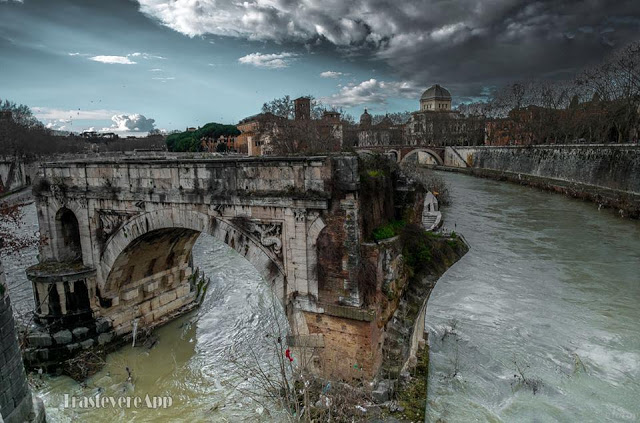 |
|
The Pons Aemilius or “Ponte Rotto”. Photo credit: Trastevere App
|
Look out over the Tiber Island from the Ponte Palatino and you’ll see the ruined remains of the Pons Aemilius. Originally made from timber, this republican era bridge was rebuilt in stone in 179 BC in the wake of a series of floods and fires that devastated much of the Tiber’s eastern bank.
The censors for the year 142 BC added arches to fortify the structure. One of these men was Scipio Aemilianus—better known to history as Scipio Africanus after his destruction of the North African city of Carthage in 146 BC. But the bridge was in constant need of repair; its maintenance essential so traders could cross from the Via Aurelia on the Tiber’s west bank to the markets and forums on the east side of the city.
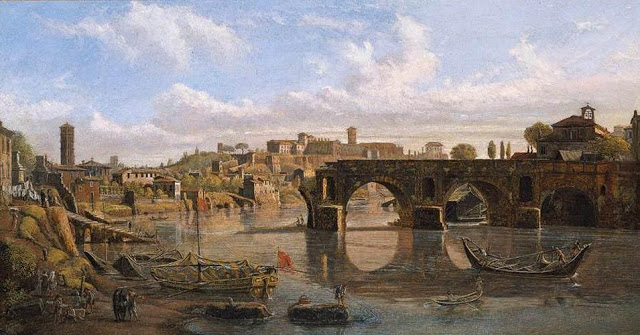 |
| “Rome: View of the River Tiber with the Ponte Rotto and the Aventine Hill” (1691) by Gaspar van Wittel. Wikimedia Commons |
The disaster prone arch bridge fared little better in the years following the fall of the Roman Empire. Further flooding weakened its structure until, in 1598, a terrible flood washed half the bridge away. Its missing half was never to be replaced, and by the seventeenth century locals were using what remained of the broken bridge as a fishing pier. Finally, in 1887, the other half was demolished to make room for the Ponte Palatino.
Fabricius Bridge
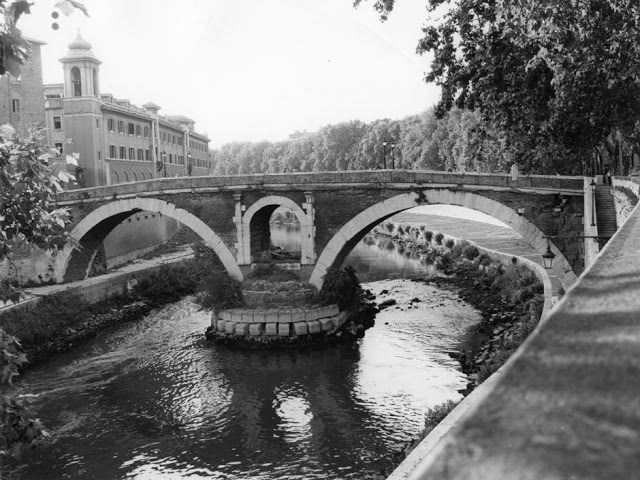 |
| The Pons Fabricius. Photo credit: American Academy in Rome |
Built during the age of Caesar and Cicero in 62 BC, and named after the curator viarum (road maintainer) for that year Lucius Fabricius, the Pons Fabricius holds pride of place as the city’s most ancient and best-preserved Roman arch bridge. In the Middle Ages, its proximity to Rome’s Jewish Quarter earned it the name Pons Iudaeorum (Jewish Bridge).
Today’s Romans might refer to it as Il Ponte dei Quattro Capi (the Bridge of Four Heads) because of the two statues of the two-faced god Janus that greet you at either end. Although Roman originals, these are modern editions, as is its brick facing. Its core tufa and peperino ash structure, however, date from the first century BC and bear testament to the extraordinary expertise of Roman engineering.
From the east bank, Fabricius Bridge takes you across the river to Tiber Island, a ship-shaped landmass that has served the same purpose since 291 BC. Once home to Rome’s Aesculapium, a famous sanctuary to the Roman god of healing, since the sixteenth century Tiber Island has been the site of the still operational Fatebenefratelli Hospital.
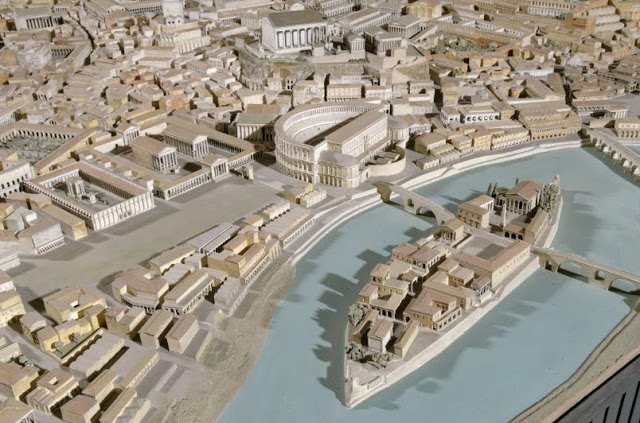 |
| Scale model of the Tiber Island connected to the Theatre of Marcellus. Photo Credit: Museo della Civiltà Romana |
Legend has it that Tiber Island was formed at the end of the sixth century BC, either after Rome’s last king, Tarquin the Proud, or all the grain he once horded was thrown into the Tiber. Fanciful though this may be, it is unfortunately just a legend. Geological studies have shown that the alluvial deposits that make up the island are actually far more ancient.
If you’re looking to cross Fabricius Bridge and Tiber Island off your list of Rome’s must-see sites, check out our Jewish Ghetto Trastevere Tiber Island Tour. Or, if you want to customise your route instead, please get in touch and we’ll arrange one of our tailored tours.
Cestius Bridge
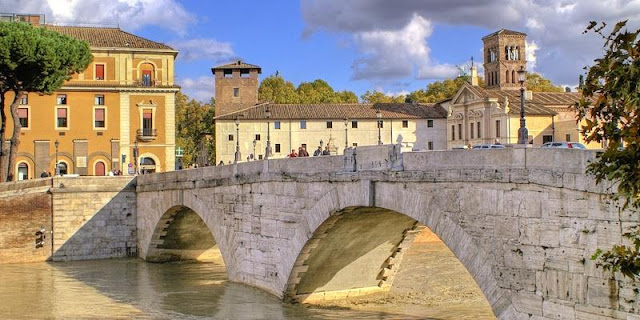 |
|
Ponte Cestio. Photo credit: Zonzofox
|
To get to Trastevere—the social hub of the city both ancient and modern—from Tiber Island, you’ll have to cross the Pons Cestius. Named after either Gaius Cestius, whose burial pyramid still stands in the city centre, or his brother Lucius, it was built around the 40s BC and repaired several times throughout the Roman period. Today’s bridge is a reconstruction, rebuilt when the Tiber’s channel was widened in the nineteenth century. Only the central arch contains any original material, some of which was taken from the nearby Theatre of Marcellus.
Ponte Sisto Bridge
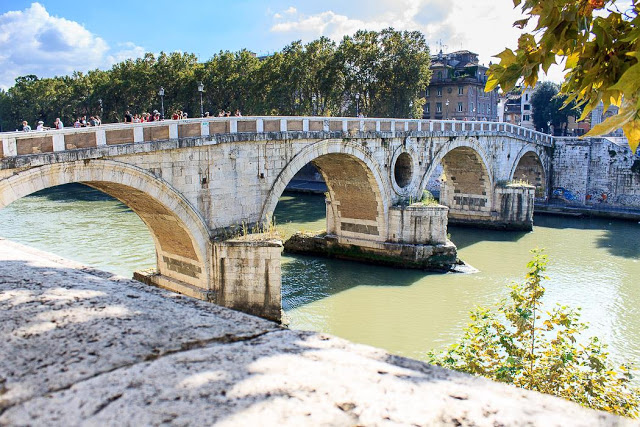 |
|
Ponte Sisto. Photo credit: Jeff Bondono
|
Don’t let appearances fool you. This bridge isn’t actually Roman but a mid to late fifteenth century reconstruction ordered by Pope Sixtus IV (from whom it takes its name). It does however stand on the site of a former Roman bridge, the Pons Aurelius, which the Lombards destroyed when they sacked Rome in the late 700s AD.
From Ponte Sisto it’s a 20-minute walk north to your next stop, Ponte Sant’Angelo. You can hug the Tiber and walk along Lungotevere dei San Gallo on the east bank if you like. But it’s far better to cut through Campo dei Fiori. Flanked by some wonderful bars and restaurants, the former epicentre of the Campus Martius is now home to the Campo dei Fiori fruit and vegetable market every Monday to Saturday (8am – 2pm).
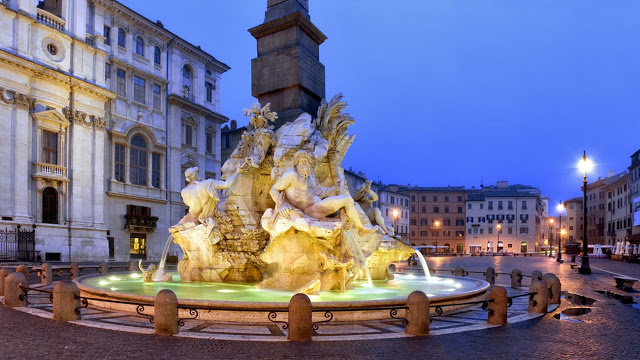 |
| Piazza Navona. Photo credit: Roman Candle Tours |
If you don’t mind taking a bit of a detour, Piazza Navona is also well worth a visit. Perhaps the most famous piazza in Rome, it takes its unusual shape from the fact it sits atop the first century AD Stadium of the Emperor Domitian. In its centre stands an Egyptian obelisk embedded in a magnificent sculpture by Bernini. If you’re feeling peckish, check out Lo Zozzone around the corner for arguably the best pizza bianca in Rome.
Sant Angelo Bridge
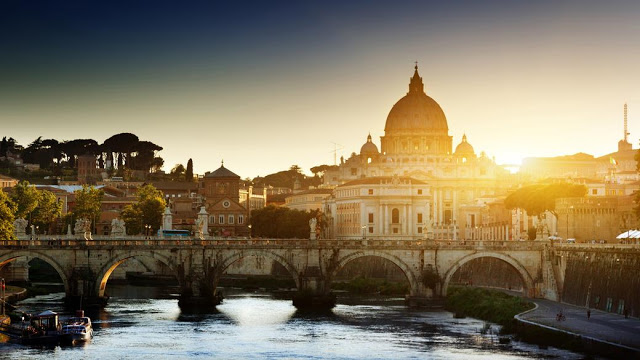 |
|
Bridge of Sant Angelo. Photo credit: Roman Candle Tours
|
Known more commonly as the Bridge of Angels because of the Renaissance era sculptures that line it, the Bridge of Sant Angelo is one of only two ancient Roman arch bridges to have survived pretty much intact from antiquity (the other being Fabricius Bridge).
It was completed under the Emperor Hadrian—or Publius Aelius Hadrianus Buccellanus as his full name was—in 134 AD, giving the bridge its Latin name, Pons Aelius. And it is one of many magnificent monuments Hadrian has left behind (the Pantheon being the most famous): something all the more surprising given that he spent the vast majority of his reign travelling the empire.
The cream of Hadrian’s architectural legacy is not in Rome but at Tivoli. It was at this trendy hillside resort that Hadrian built his magnificent villa complex—one of the world’s most impressive Roman sites—which you can visit on our Tivoli tour. But his Mausoleum in Rome is no less monumental. In fact it has survived to this day as the circular structure now known as Castello Sant’Angelo, purpose built for his dynasty, which is connected to the Campus Martius via the Bridge of Sant Angelo.
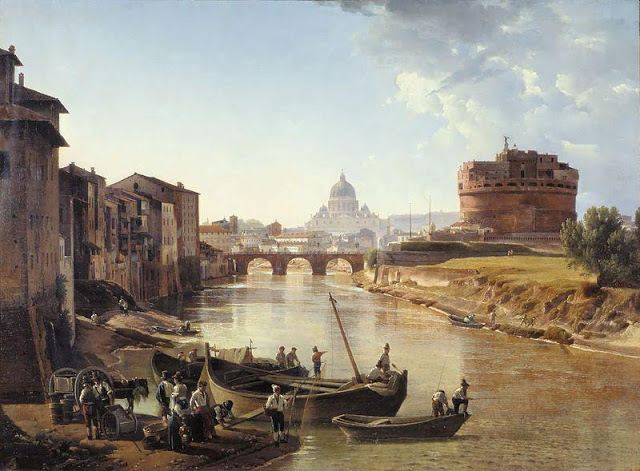 |
| “Rome, View of the Tiber River and Castel Sant’Angelo” by Sylvester Shchedrin (1823/5). Wikimedia Commons |
The façade and road surface of Sant Angelo Bridge may have been renovated over the years to accommodate for the countless number of Vatican pilgrims who used the bridge as the main thoroughfare, but three of its five arches are Roman originals. Among the 10 angelic statues that line the bridge, two are copies of Bernini (the originals are in the nearby basilica of Sant’Andrea delle Fratte).
Milvian Bridge
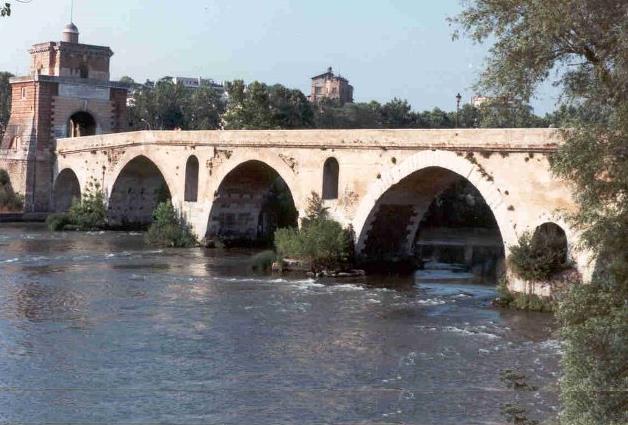 |
|
Milvian Bridge. Photo credit: Turismo Roma
|
A quick glance at the map may convince you that Ponte Milvio is a bridge too far. And to be fair it is quite a bit outside Rome’s historic centre. We’re happy to arrange transport if you want us to include the Milvian Bridge as one of the sites for your private tour of Rome. If not, you’re best off taking the bus (the 53, 201, C3 or N25 in the direction of P. Milvio) or the tram (the stop Pinturicchio).
For anyone passionate about history, however, the Milvian Bridge is an essential site. For it was not just the site of one of the bloodiest battles in Rome’s long history of civil war, the Battle of Milvian Bridge. It was the outcome of this battle that launched Christianity from being one of the Roman Empire’s many obscure cults to an official world religion.
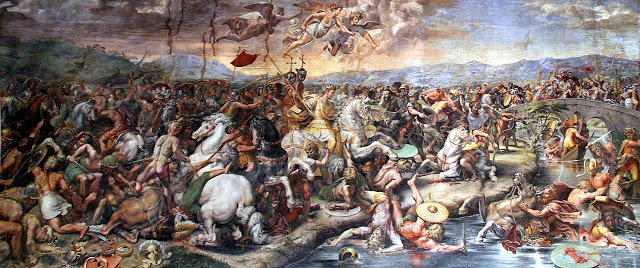 |
|
“The Battle of the Milvian Bridge” (1520 – 1524) by Giulio Romano. The bridge is visible at the left of the image, Constantine in the centre. Wikimedia Commons
|
On the morning of October 28, 312 AD, two rival emperors drew up their armies on the vast plain just north of the bridge. At the head of one army was Constantine I, declared emperor six years earlier in York, England, and now marching on Rome to claim his throne. Defending the way to the city, which consisted of both the Milvian Bridge and another hastily constructed wooden pontoon, was his rival Maxentius, who, as the son of a former emperor, had too declared himself ruler of the Roman world.
Constantine was confident. The evening before the battle he had seen something in the sky, a cross containing the words in hoc signum vincis (under this sign you were win). Later that night he’d dreamt that Christ had visited him and told him to use the sign of the cross against his enemies. So, as dawn broke, Constantine instructed his men to paint the sign of the cross on their shields.
Constantine won a crushing victory at the Battle of Milvian Bridge. Maxentius and his men were quickly routed and driven back across the wooden pontoon. Whether it was rigged to collapse or simply buckled under the weight of the army we don’t know. What we do know is that the bridge collapsed, throwing Maxentius and hundreds of his legionaries into Tiber where they drowned under the weight of their armour.
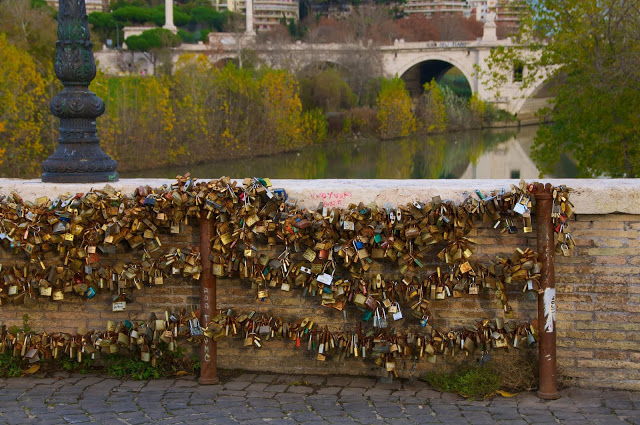 |
|
Padlocks on the Milvian Bridge. Photo credit: Pages From Italy
|
What once was the site of crossed swords is now a place of pilgrimage for star-crossed lovers. For better or for worse, today the Milvian Bridge is better known as padlock bridge on account of the padlocks left by young lovers that line it. After locking them shut, these lovers then throw their keys into the Tiber to symbolise their internal bond. The Roman authorities are, however, now taking bolt cutters to these padlocks as they threaten the bridge’s stone structure. Whether or not you hope the longevity of the offending lovers is quite as fallible is up to you!
Roman Candle Tours in Rome
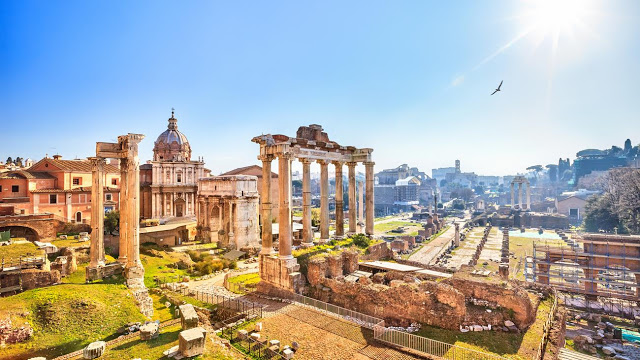 |
|
The Roman Forum. Photo credit: Roman Candle Tours
|
Rome wasn’t built in a day, and it’s a tough ask trying to pack all its sites into one. While at Roman Candle Tours we do offer a day tour of Rome and the Vatican, we also offer a range of specialised tours according to what you want from the Eternal City.
Ancient enthusiasts look no further than our Ancient Rome tour which covers the big three: the Colosseum, the Roman Forum, and the Palatine. We also offer a number of tours from Rome, including our trip to the Catacombs and Hill Towns of Rome and a snapshot of everyday life in ancient Rome’s port city through our Ostia Antica Tour.
And remember, if this itinerary has caught your eye or you have something else mind, we’d love to hear from you. Do feel free to get in touch and together we’ll help you create one of your own personalised private tours of Rome.
